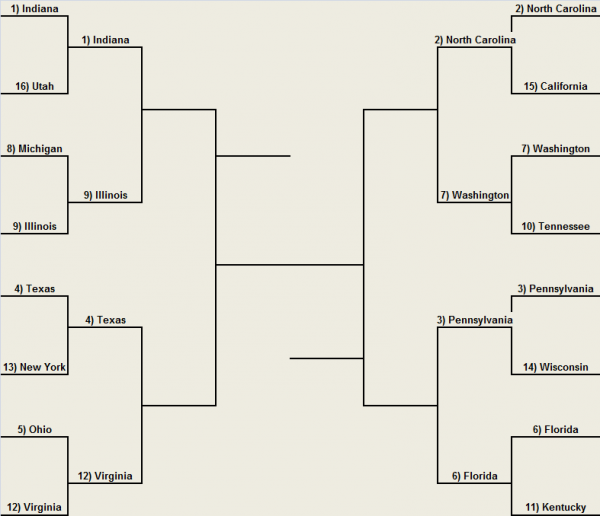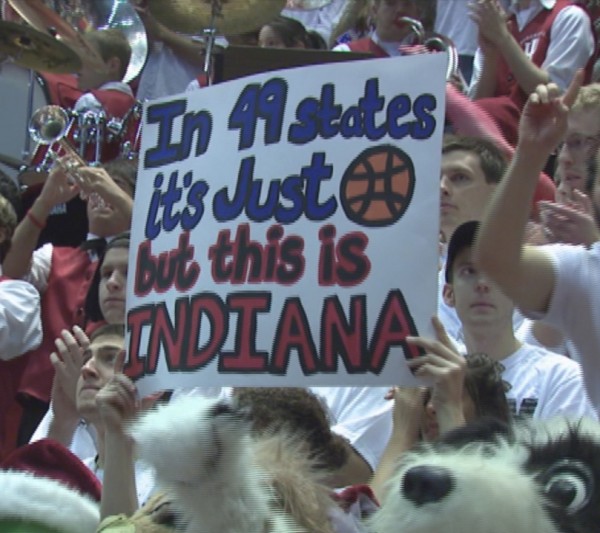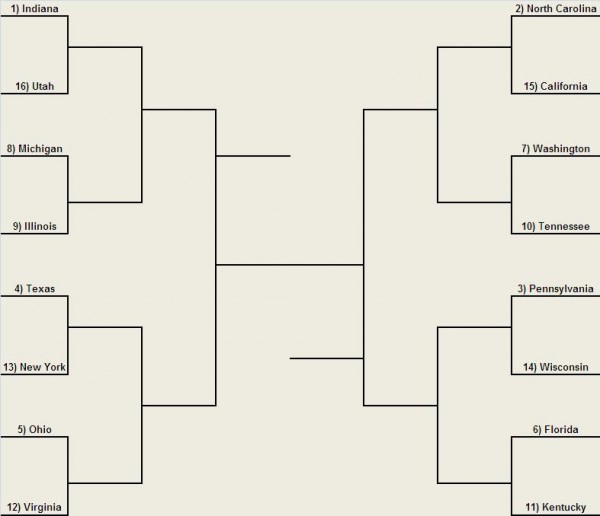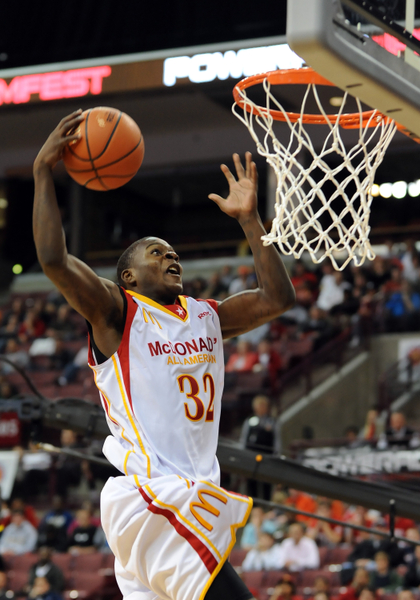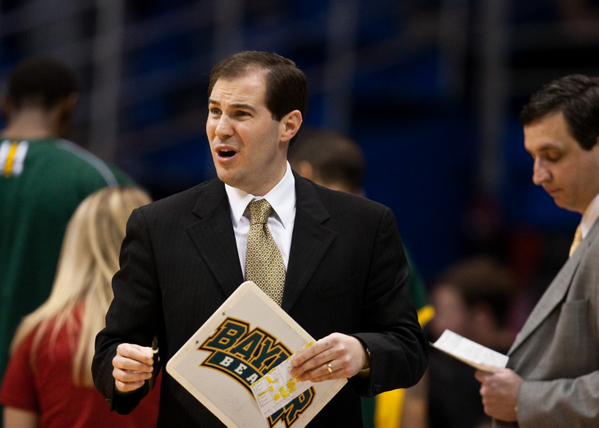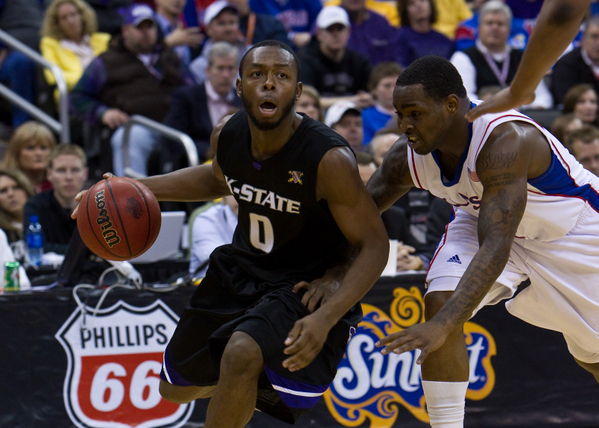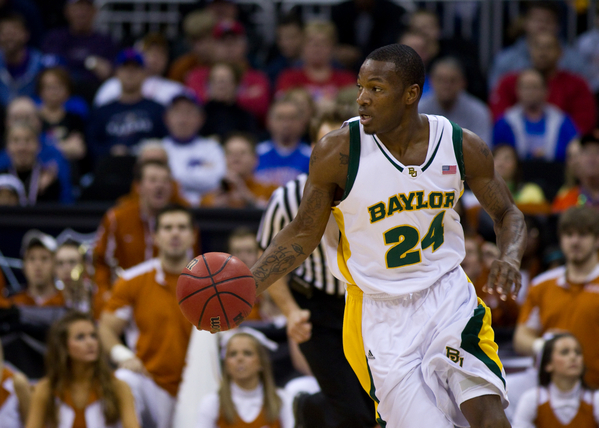The RTC Big Four State Tournament: Final Four
Posted by rtmsf on September 14th, 2010We’re now down to the Final Four of the RTC Big Four State Tournament. Last week was the quarterfinal round, and we saw as three of the favorites (#1 Indiana, #2 North Carolina, #4 Texas) advanced to the Final Four while #3 Pennsylvania was downed at the buzzer by upstart #6 Florida. There was a very strong public consensus among the top two seeds advancing (85% and 90%, respectively), while the fan vote was a little less confident in Pennsylvania (70%) and Texas (72%). Of course, we here at RTC had the Sunshine State (with afternoon rain) squad coached by Billy Donovan springing the upset over PA, so it’ll be interesting to see how far we think they can continue to their run. Here’s our current bracket, with the F4 breakdowns below.
Final Four Matchups (Quarterfinal fan vote pct. listed)
#1 Indiana (85%) vs. #4 Texas (72%)
Nitpicking is the only way to find weaknesses on the rosters of Indiana and Texas, two hoops-loaded states with a great deal of pride on the line in this anticipated semifinal matchup. The raw talent level of Texas should prove Indiana’s stiffest challenge thus far in the tournament. From the Nate Robinson-style leaping ability of UTEP’s Randy Culpepper to the physicality and shooting prowess of Texas’ Jordan Hamilton to the Kevin Garnett comparisons that Baylor’s Perry Jones is receiving before he makes his Bears debut, Indiana’s status as tournament champion favorite is in serious jeopardy. This especially rings true when Texas comes out of the gates sprinting up and down the floor, boosted by the red-hot shooting of LaceDarius Dunn, the preseason Big 12 Player of the Year candidate and the school’s all-time leader in threes made. Gary Johnson takes Robbie Hummel to the hole on a spin move and the foul. Dunn throws an alley-oop to Jones that gets the crowd on their feet and forces Indiana to use a timeout. Culpepper races from end to end for the flush. A ten-point halftime lead gives the top seed a moment of pause in the locker room.
Here’s the point where Indiana’s senior-laden roster and big-game experience becomes a factor. The collected demeanor of Brad Stevens in the locker room calms his troops, the gameplan is slightly tweaked to force Texas into a halfcourt game, the physicality of Indiana’s Shelvin Mack and Hummel is asserted, and Indiana slowly but surely drains the deficit. The steady and levelheaded Mack leads the force, hitting clutch mid-range jumpers as the shot clock winds down. Just when Texas is about to corral the momentum once again, a JaJuan Johnson rejection of Jones effectively punks the youngster. As the score inches closer and the pressure mounts on such a monumental stage, it’s Texas taking their fair share of poor shots while Indiana lives at the free throw line, led by Hummel at 90%. His four consecutive makes seals the deal and Indiana escapes by a slim margin for a spot in the finals.
RTC Choice: Indiana 68, Texas 65
#2 North Carolina (90%) vs. #6 Florida (30%)
In an all-too-familiar situation when a Cinderella makes a run to the national semifinals, they usually come up against a seasoned, experienced and talented team who expected to be there all season long. The result is not often pleasant for the underdog, who quickly realizes that it’s in over its head and needs to make hasty plans for a return flight later that evening. This is what Billy Donovan’s team faced in matching up against the boatload of NBA lottery pick-level talent that North Carolina threw at them. Predictably, the game was over in the first ten minutes. The offensive firepower of Kyle Singler, Harrison Barnes and Tracy Smith got off early inside the paint, but it was a quick whistle (actually, series of whistles) on Florida’s Chris Singleton that set the tone early. Three quick fouls meant that the inside defensive presence that Florida was relying upon to slow down the North Carolina bigs was no longer available. Gus Gilchrist and Chandler Parsons, while capable offensive players, are not known for their ability to stop people, especially players the caliber that NC brings to bear.
By halftime, Florida was already down 22 points and not only looked demoralized but also emotionally and mentally exhausted from their previous nailbiters in this tournament. From that point on, Coach K put his guys into a cruise control situation, running clock but finding their spots, as Florida tried desperately to cut into the lead. A couple of times Donovan’s team had cut the margin down to a 12-point game, only to watch helplessly as Nolan Smith or CJ Harris drained a three or Barnes slashed his way to another dunk. There was no confusion as to who the better team was in this particular game, and North Carolina moved on to the tournament finals to play the top overall seed Indiana in an upcoming battle of epic proportions. Coach K vs. Brad Stevens; Nolan Smith vs. Shelvin Mack — where have we seen that before?
RTC Choice: North Carolina 77, Florida 62.
RTC State Tournament Championship: Thursday 9/16
































